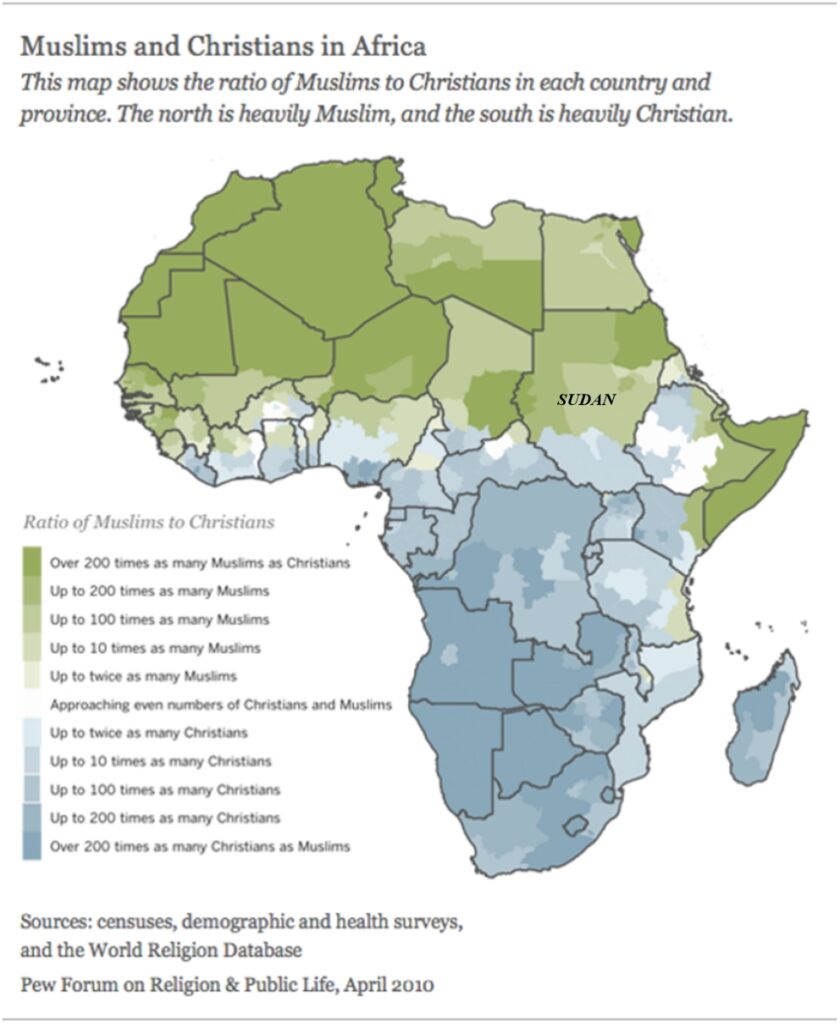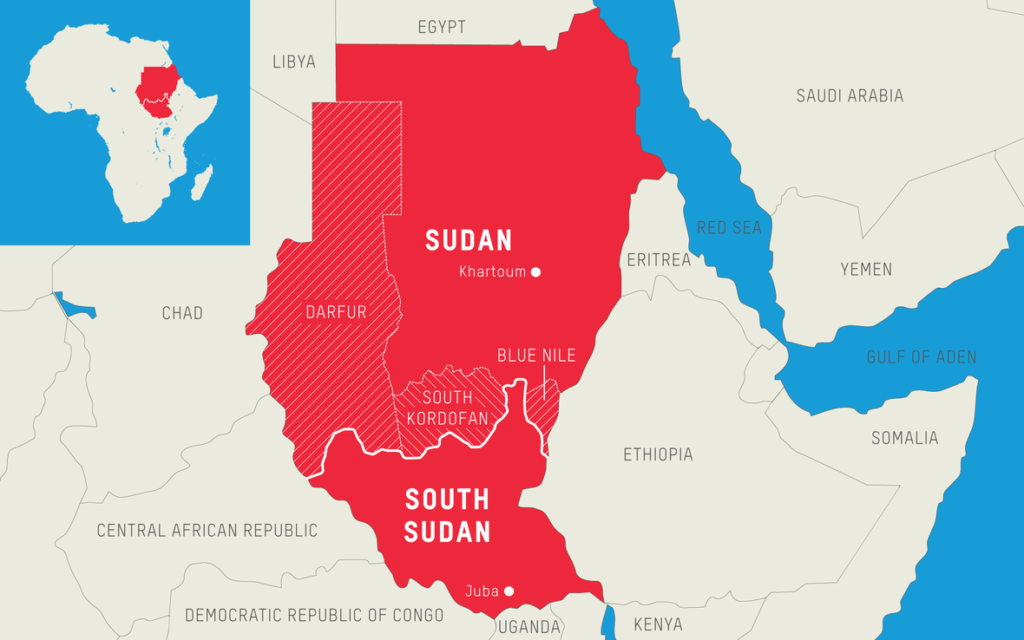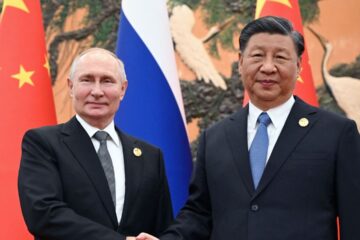SUDAN and SOUTH-SUDAN: the forgotten wars
I. A North-South ethno-religious divide
The Sudanese population is spread over Sudan along ethno-religious lines:
- The North → majority of Arab Muslims
- The South → majority of Black Christians/Animists

It is worth noting that, between 1899 and 1956, both Great Britain and Egypt administered what was called “Anglo-Egyptian Sudan“. During this period, they used the “divide and rule” strategy and accentuated differences between the North and the South. In fact, British colonisers based social hierarchies on whether one was Sudanese Arab or Sudanese African.
II. South-Sudan fought for its independence
Sudan’s Southern region fought for its independence through two civil wars between 1956 and 1972 and between 1983 and 2005. The last conflict caused the death of 2 million people and forced 4 other million away from their home.
In 2005, the Sudanese government and the Sudan’s People Liberation Army (SPLA) agreed on the organisation of a self-determination referendum for the Southern region of Sudan in 2011.

As a result, in 2011, South-Sudan gained its independence with almost 99% of the votes. It rapidly became officially recognised by the United Nations and the African Union.
Despite the richness of its soil in oil, South-Sudan has been victim of the resource curse (like the Democratic Republic of Congo). Only 100km of its roads are tarmacked and only 25% of the South-Sudanese population is literate.
As a matter of fact, the lack of effective state institutions, corruption, personal rivalries and private (over)exploitation of natural resources sparked new clashes among South-Sudanese.
III. Since its independence, South-Sudan is consumed by a civil war

In 2013, President Salva Kiir, who belongs to the Dinka ethnic group, laid off his vice-President Riek Machar, who belongs to the Nuer ethnic group, as he was allegedly preparing a coup.


This event threw the country into a violent civil war. It officially lasted 5 years (2013-2018) until the signing of the Revitalised Peace Agreement in Addis Ababa and the formation of a transition government with Salva Kiir as President and Riek Machar as Vice-President. However, fighting kept going until 2020 when both leaders pledged to form a national union government and follow the provisions of the 2018 peace agreement.
The Sudanese civil war embodies those “forgotten wars” that do not get the attention they deserve from the Western media despite their dire events. Indeed, the conflict killed 400,000 people and displaced 4.5 million more, half of them fled to neighbouring countries like Uganda. Militaries of both sides have perpetrated mass executions, hangings, burnings and rapes. Furthermore, this civil war caused economic distress (substantial inflation and fall of the gross national income). It also gave birth to a famine in 2017 because fighting have been taking place on agricultural lands. The lasting effects of this famine are still felt nowadays.
Besides, still to this day, armed group leaders and clan chiefs in both camps do not manage to uphold their authority amongst their troops. In fact, both in South-Sudan and Sudan, there are no proper armies, only independent militias whose crimes remain unpunished. The security situation in South-Sudan is far from being settled and appeased.
IV. The war in Darfur, Sudan: the 1st genocide of the 21st century

In Sudan, a war in the Darfur region is raging since 2003. The Sudanese government, and its ally the militia Janjaweed (from which was created the Rapid Support Forces in 2013), have been perpetrating ethnic cleansing against Darfur’s non-Arab populations and in particular against the following ethnic groups: the Fur, the Zaghawa and the Masalit. In response, the Sudan Liberation Movement and the Justice and Equality Movement, two non-Arab rebel groups, have taken up arms.
The International Criminal Court has indicted the Sudanese President, Omar al-Bashir, for genocide (among other charges).
As a matter of fact, the war in Darfur killed several hundreds of thousands of people. In 2008, the UN estimated that 300,000 people had died from fighting. Besides, many Sudanese fled the Darfur region and have ended up in refugee camps located in Chad.
Even though the war in Darfur appears to be a racial conflict, other factors like water and land usage have to be reckoned with.
V. The 2019 revolution in Sudan
Omar al-Bashir was deposed in April 2019 by a coup organised by the Sudanese army. He himself became head of state after a coup in 1989.
This episode unfolded after months of street protests demanding al-Bashir departure. Demonstrators originally pointed out the deterioration of their living conditions due to a galloping inflation.
A federal transitional government was then established to lead the country through a democratic transition until 2026.

Another coup occurred in 2021. Two generals rose to power: Gen. Bourhan was the first in the hierarchy and was followed by Gen. Hemedti (leader of the Rapid Support Forces involved in the War in the Darfur). However, their rivalry rapidly increased as Gen. Bourhan brought back into the government some members of al-Bashir’s regime that Gen. Hemedti helped to overthrow in 2019.




5 Comments
The end of UN PEACE MISSIONS ? – geopol-trotters · 4 June 2025 at 8:38 pm
[…] example of UNMISS in South Sudan illustrates the inadequacy. As of 2023, this was the largest UN peacekeeping mission, with around […]
From Clinton to Biden: a look back on 30 years of US leadership – geopol-trotters · 21 March 2025 at 10:39 am
[…] 2017, the US President imposed a travel ban on 7 Muslim countries (Iran, Iraq, Syria, Yemen, Libya, Sudan, and Somalia) for “security […]
RUSSIA, a predator in AFRICA – geopol-trotters · 11 September 2023 at 7:29 am
[…] Wagner group is present in Sudan since 2018 but Russian economic presence has been recorded for more than a decade now. Sudan is the […]
CHINA in AFRICA, a “shared future”? – geopol-trotters · 11 September 2023 at 7:16 am
[…] and maybe participate in the diplomatic resolution of local conflicts as it tried to do during the 2013-2018 South-Sudan civil war. Will it be comfortable doing it ? Maybe not but what other choice does it have ? It already does […]
UGANDA: the “Pearl of Africa” - geopol-trotters · 30 January 2023 at 9:55 pm
[…] in Uganda, it seems to be still active, though to a lesser extent than it used to be, in the DRC, South-Sudan and the Central African […]